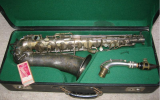VINTAGE 435HZ SAXOPHONES
GATHERED INFORMATION ABOUT (POSSIBLE) 435Hz SAXOPHONES.
This article contains info about vintage saxophones that might have been designed for Concert Pitch A4=435Hz, the so called “Diapason Normal”, the national concert pitch used in France between 1859 and WWII.
I became interested in those vintage horns during my search for a solution for performing with saxophone using Concert Pitch A4=432Hz. The difference between 435Hz and 432Hz is only 3Hz, with some practice (and getting acquainted with the instrument) intonation corrections with the embouchure would be manageable.
At present time there is one saxophone manufacturer, Borgani, that has made the first 432Hz saxophone in December 2014. Read more about that in this article.
More information about 432Hz as Concert Pitch can be found here.
BUFFET, EARLY BUFFET-CRAMPON
- Series I: 1866 to 1870; s/n 0 thru 792 (“Buffet”).
- Series II: 1871 to 1887; s/n 793 thru 7xxx (“Buffet-Crampon, Cie.”).
- 1887 to 1927; s/n 7xxx thru 29424 (“Evette-Schaeffer System”).
— Quote —“A Note On Pitch
“France had several different pitch standards in the 19th century. When Buffet’s first sax was introduced, it was probably a A=435hz horn, which was the French standard of the time. By 1914, the new international standard pitch of A=440hz (“low pitch”) was introduced. Buffets around this time are stamped “LP” or “HP” — “HP” being “high pitch”: an American standard where A=457hz.
So, if you find one of these older horns, look for the “LP” stamp near the “Evette & Schaeffer” engraving. If you don’t see it, the horn might be fun to have as a collectible or if you do solo work (or work with electronic instruments), but not as a performance horn with modern ensembles.“
— End Quote —
Side note: We could conclude that a vintage Buffer/Buffet-Crampon from before 1914 “might be” in concert pitch A4=435Hz IF the sax is WITHOUT the “LP” (low pitch) stamp engraved on the horn!
Source: http://www.saxpics.com/
EVETTE-SCHAEFFER SYSTEM
— Quote —
“Low B models. These models, functionally and visually identical to earlier horns, were available (probably) as the low-cost or “introductory” line. Couesnon, Sax and other French-manufacturers also sold their low B horns as low-cost models … these horns may have been A=435hz horns (French standard pitch) and discontinued “around” 1914 when the A=440hz (low pitch) international standard was introduced.”
— End Quote —
Source: http://www.saxpics.com/
G.H. Hüller “870” SAXOPHONES


— Quote E. Weller —
“Bei der Angabe “870” … die bis 1939 übliche Normalstimmung von 435 Hz (= “Doppelschwingungen”, daher 870 einfache Schwingungen).”
— End Quote —
Translation:
“With the specification “870” … until 1939 the usual standard tuning of 435 Hz (= “double vibration”, therefore 870 simple oscillations).”
Source: http://www.museum-markneukirchen.de
— Quote —
“At A=435 the intonation on mine was really excellent. With the tuner set to A=440 it was still definitely good for a vintage sax, but it took some effort to keep the bottom end from being flat. To be honest, I think I’d have got used to it fairly soon: mouthpieces with smaller chambers helped. Serial number was 362XX, with 870 on the crook tenon receiver. This is the pitch: an octave above concert A at 435Hz (“Diapason normale”, a French standard used until 1939.) Some of the Hullers are marked 880 (i.e. an octave above A=440).”
— End Quote —
Source: “sax-ony “, (Distinguished SOTW Member/ Forum Contributor 2010), http://www.saxontheweb.net/.
… and …
— Quote —
“I have wondered what is the meaning of the number “870” found on the receiver of every Huller saxophone that I’ve ever seen or seen pics of. Recently, I was reading something that seems to explain it.
I read that 870 is the Paris standard pitch: A=435 (870/2). The Paris standard dates from 1859 and apparently is the only official standard…whatever that means.”
— End Quote —
Source: “xax“, (Distinguished SOTW Member), http://www.saxontheweb.net/.

